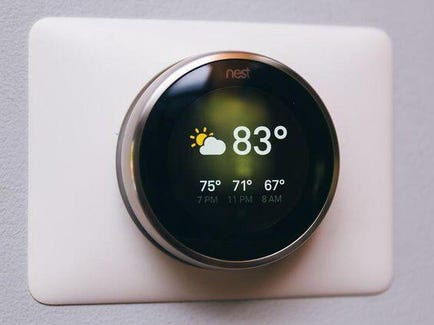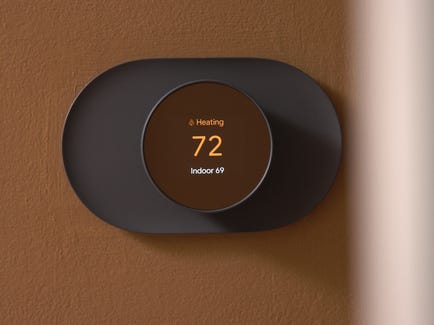 Why You Can Trust CNET
Why You Can Trust CNET Nest Learning Thermostat vs. Nest Thermostat: Which Should You Buy?
Google's two smart thermostats have some key differences. Here's how to decide which is best for your home.

Like
- The $249 Nest Learning Thermostat has a larger display, a better resolution and a far-field sensor for viewing time and temperature information from a distance
- It works with Google Assistant and Alexa -- and Nest *finally* sells a temperature sensor as an optional accessory.
Don't like
- The Nest Learning Thermostat isn't compatible with Apple HomeKit.

Like
- Its $130 price
- Improved design
Don't like
- It doesn't work with Siri
- Right side controls not ideal for lefties.
In this article:
If you're thinking about purchasing a smart thermostat, Google's two Nest options are worth considering. The Learning Thermostat is Nest's flagship product, first introduced in the early 2010s, years before Google bought the emerging startup. Now in its third generation, the $249 Nest Learning Thermostat continues to be a staple for the brand.
Nest has added more than a dozen other devices in the last decade, such as video doorbells, smart speakers, displays and routers. It's also made an effort to introduce products for different budgets, especially within the smart thermostat category -- including the $130 Nest Thermostat, introduced in 2020. This newer thermostat has a lot to offer despite costing $119 less than the original.
So, which Nest model is the best? Below we'll dig into the key differences between these two Google thermostats. (Once you do pick one, we've got a guide for how to install your Nest thermostat. We've also got comparisons of Nest Thermostat vs. Amazon Smart Thermostat, Nest Thermostat vs. Ecobee3 Lite and Ecobee Smart Thermostat Premium vs. Nest Learning Thermostat.)
The Nest Learning Thermostat is the Google company's premium smart thermostat. Available for $249, the third-gen Learning Thermostat features a metal ring and a high-res display.
Its classic turn dial design lets you navigate among the settings and you can press down on the thermostat to make a selection. It's easy enough to use, but I prefer the new Nest Thermostat's side controls (more on this in the next section). You can still set up this model using the Nest app and control it in the Google Home app. The new Nest Thermostat, in contrast, only works in the Google Home app.
The Learning Thermostat is available in seven different color finishes: stainless steel, mirror black, brass, polished steel, white, black and copper. It comes with a trim kit if you need to cover up old holes or paint. And it works with the optional Nest Temperature Sensor accessory, sold separately for $39 each or in a three-pack for $117 (currently on sale for $99).
Its high-res display offers a feature called Farsight that displays the weather, time or temperature when it senses your presence. This model also has a learning algorithm that's designed to adapt to your schedule over time and automatically make adjustments on your behalf. It also uses a proximity sensor to determine your home or away status.
The Nest Thermostat has the same rounded shape as the Learning Thermostat -- and both work with compatible smart speakers and displays (sold separately). That's where their similarities end.
Google got rid of the turn dial on the new Nest Thermostat. Instead there's a touch control strip on the right side for adjusting the temperature and making other changes to your settings. I like this update, but wish the controls were available on both the right and the left side so us lefties could control it more comfortably. Still, I found the controls responsive and intuitive and an overall improvement over the previous turn dial approach.
This model is made of plastic and features a mirrored finish, as well as different color options than the Learning Thermostat. It's available in snow (white), sand (rose gold), fog (light greenish/blueish-gray) and charcoal (dark gray). Matching trim kits are sold separately for $15 each. This one doesn't work with the Nest Temperature Sensor accessory. It also doesn't have the high-res display and "Farsight" feature offered with the Learning Thermostat.
The Nest Thermostat is the first of the company's thermostats that doesn't work with the Nest app (the original app that still houses some legacy products, including the Nest Learning Thermostat). Instead, this model can only be set up and controlled in the Google Home app.
It also won't learn your schedule over time and adjust accordingly. It lets you enter a schedule and will automatically switch between home and away modes based on the thermostat's built-in proximity sensor.
Which Nest should you get?
There's no wrong answer here; both thermostats are excellent. Just consider your specific needs before you buy. If you're looking for a more substantial, premium design, go for the Learning Thermostat. It has more color finish options, comes with a trim kit and offers some advanced features, such as the learning algorithm, the Farsight feature and compatibility with the optional Nest Temperature Sensor accessory.
The Nest Thermostat is considerably less expensive than the Learning Thermostat. It offers an updated mirrored design in four color finishes and a refreshed side control thermostat interface. Your purchase doesn't include a trim kit and the thermostat isn't compatible with the Nest Temperature Sensor. It also doesn't have the same learning algorithm or Farsight. But for over $100 less than the Learning Thermostat, the new Nest Thermostat is an excellent option that holds its own against Google's flagship thermostat.

